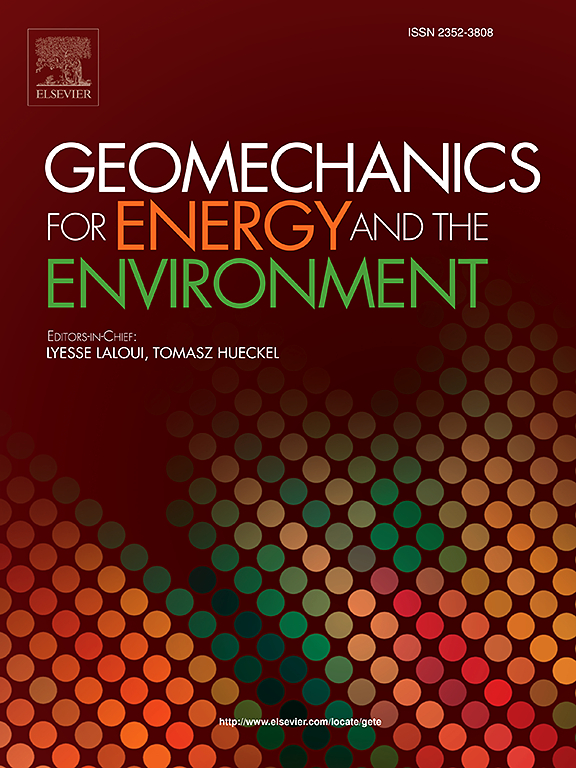Influence of the strain rate on the deformation and failure of rocks with multiscale cracks
IF 3.7
2区 工程技术
Q3 ENERGY & FUELS
引用次数: 0
Abstract
The deformation and failure of rock are affected by the strain rate. However, the effect of the strain rate on rock failure has not been well studied at the microscale level. This study focuses on this complexity by constructing a three-scale wing-shaped crack propagation model that accounts for the interactions between cracks. Based on this model, we determined the initiation and coalescence times of 3 scale levels cracks to reveal the effect of the strain rate on the propagation and failure patterns of multiscale cracks. In addition, we analyzed the critical strain rate (strain rate required for simultaneous coalescence of adjacent scale-level cracks) that leads to failure. The results show that both crack initiation and coalescence times decrease significantly with increasing strain rate and that an increase in initial crack length leads to earlier crack initiation. For the multiscale crack model, as the strain rate increases, large-scale cracks (1-st-scale level cracks) coalesce first, followed sequentially by medium- and small-scale cracks (2-nd and 3-d-scale level cracks). Furthermore, we observed that the critical strain rate initially increases and then decreases with increasing initial crack concentration. Moreover, both an increase in the initial crack length and size decrease factor (ratio of the length of a specific scale-level crack to the length of adjacent larger scale-level cracks) lead to a decrease in the critical strain rate, further confirming the influence of crack size on the failure properties of rock. A comparison with the existing theoretical model shows that the proposed theoretical model is reasonable.
应变速率对多尺度裂纹岩石变形破坏的影响
岩石的变形和破坏受应变速率的影响。然而,在微观尺度上,应变速率对岩石破坏的影响还没有得到很好的研究。本研究通过构建一个考虑裂纹间相互作用的三尺度翼形裂纹扩展模型来关注这一复杂性。基于该模型,确定了3个尺度裂纹的起裂时间和聚结时间,揭示了应变速率对多尺度裂纹扩展和破坏模式的影响。此外,我们分析了导致破坏的临界应变速率(相邻尺度级裂纹同时合并所需的应变速率)。结果表明:随着应变速率的增加,裂纹起裂次数和合并次数均显著减少,且初始裂纹长度的增加使裂纹起裂时间提前;对于多尺度裂纹模型,随着应变速率的增大,大尺度裂纹(1-st级裂纹)首先合并,其次是中、小尺度裂纹(2- d级和3-d级裂纹)。随着初始裂纹浓度的增加,临界应变速率先增大后减小。初始裂纹长度和尺寸减小系数(特定尺度裂纹长度与相邻较大尺度裂纹长度之比)的增大均导致临界应变速率的减小,进一步证实了裂纹尺寸对岩石破坏特性的影响。与现有理论模型的比较表明,本文提出的理论模型是合理的。
本文章由计算机程序翻译,如有差异,请以英文原文为准。
求助全文
约1分钟内获得全文
求助全文
来源期刊

Geomechanics for Energy and the Environment
Earth and Planetary Sciences-Geotechnical Engineering and Engineering Geology
CiteScore
5.90
自引率
11.80%
发文量
87
期刊介绍:
The aim of the Journal is to publish research results of the highest quality and of lasting importance on the subject of geomechanics, with the focus on applications to geological energy production and storage, and the interaction of soils and rocks with the natural and engineered environment. Special attention is given to concepts and developments of new energy geotechnologies that comprise intrinsic mechanisms protecting the environment against a potential engineering induced damage, hence warranting sustainable usage of energy resources.
The scope of the journal is broad, including fundamental concepts in geomechanics and mechanics of porous media, the experiments and analysis of novel phenomena and applications. Of special interest are issues resulting from coupling of particular physics, chemistry and biology of external forcings, as well as of pore fluid/gas and minerals to the solid mechanics of the medium skeleton and pore fluid mechanics. The multi-scale and inter-scale interactions between the phenomena and the behavior representations are also of particular interest. Contributions to general theoretical approach to these issues, but of potential reference to geomechanics in its context of energy and the environment are also most welcome.
 求助内容:
求助内容: 应助结果提醒方式:
应助结果提醒方式:


